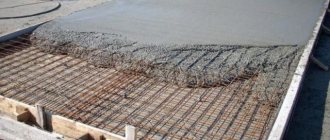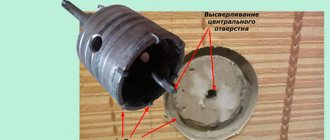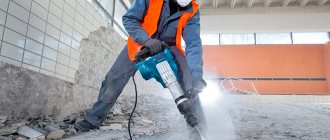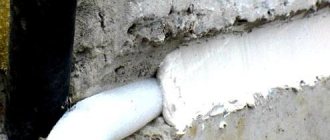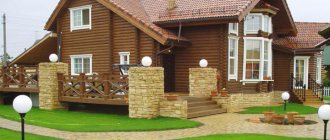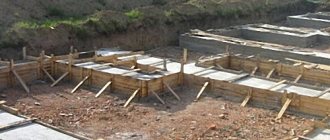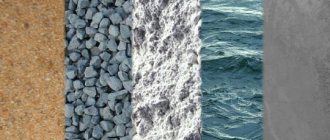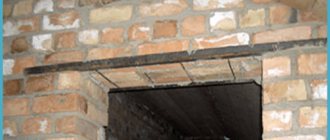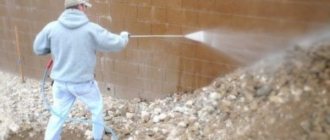Author: V.M. Schwartz, V.V. Ivannikov, A.G. Nikolaev, O.B. Ryabov, V.N. Stepanov (JSC NORE).
Published in the journal Chemical Technology No. 10/2015
The largest number of defects and damages during inspections of industrial buildings and structures built before the early 80s of the last century occurred on brick walls. A considerable part of these defects are cracks in the brickwork.
The study of cracks, identifying the causes of their occurrence and the dynamics of development is a critical stage in the inspection of brick walls of buildings. The presence of cracks reduces the structural reliability of the building and its operational qualities, and significant cracks in the load-bearing walls create a threat of destruction of the building.
The reduction in load-bearing capacity is especially pronounced in the presence of horizontal cracks in the walls and vertical cracks in structures above the wall openings. The presence of cracks in the brickwork is also a harbinger of more serious damage to the walls due to the properties of the brickwork to resist compression well, but much worse than tension. As a result, cracks appear on the stretched surface of the masonry long before its destruction.
Proper care of brickwork, timely repairs and sealing of cracks in brick walls make it possible to significantly increase the strength, reliability and service life of the entire building.
Shrinkage cracks: acceptable values
Cracks in concrete are stress concentrators and the cause of destructive factors. The ingress and freezing of water in winter leads to further expansion of the defect, peeling off pieces of adjacent material, exposure of reinforcement and partial destruction of the structure.
Therefore, this factor is regulated by the requirements of current regulatory documents, in particular the requirements of SNiP 52-01-2003 “Concrete and reinforced concrete structures. Basic provisions".
Permissible values of shrinkage cracks in concrete SNiP 52-01-2003:
- No more than 0.3 millimeters during prolonged opening (in accordance with the safety conditions of the reinforcing belt).
- No more than 0.4 millimeters during prolonged opening (based on the conditions of safety of the reinforcing belt).
- No more than 0.2 millimeters for long-term crack opening (for sealed structures).
- No more than 0.3 millimeters for short-term crack opening (for sealed structures).
Concrete defects are not allowed in the following cases:
- Structures operating under excess pressure of liquids or gases.
- Structures and products with increased durability.
- Structures operating in conditions of increased aggressiveness of the environment.
Types of cracks in reinforced concrete elements: acceptable and unacceptable
When accepting reinforced concrete structures at a construction site, the first step is to evaluate their technical characteristics. characteristics in appearance. In case of non-compliance, the customer has the right to make claims to the manufacturer, supplier or contractor. The issue of the admissibility of cracks in this case is of paramount importance, so it is worth dwelling on it in more detail.
Non-hazardous cracks in reinforced concrete elements
Any occurrence of a crack in a structure indicates the presence of a discharge of accumulated stress in a specific area of the element. The reasons for their appearance may be internal stresses (tensile). As a rule, they arise as a result of processes occurring inside the element, as well as as a result of external loads on the product.
Within the framework of DBN B.2.6-98:2009, for various reinforced concrete elements and structures there are separate requirements for the formation of cracks. Thus, for specific elements, some types of cracks are acceptable. For others, it is completely unacceptable.
In the table below, we will look at the types of non-hazardous cracks, as well as the reasons for their occurrence.
| Types of cracks | Causes | Crack size | Character of cracks |
| Cracks that occur during structure shrinkage (shrinkage) | Inappropriate concrete composition (a lot of cement - 600-700 kilograms per cubic meter). Poor quality reinforcement. Violations of the hardening process or improper maintenance of the product during the hardening process of concrete. | up to 0.1 mm. | Stabilized/ unstabilized |
| Deformation | They appear as a result of careless transportation and storage in a warehouse. They may occur during installation, as well as during operation of products. | up to 0.3 mm. | Stabilized, one-sided, end-to-end |
| Cracks that occur when technological processes are disrupted during production (technological) | They arise as a result of delamination of the mixture during laying, compaction or vibration. Deformations are often observed that appear as a result of violation of the heating regime of the concrete mixture, improper tension of the reinforcement in the prestressing elements. | up to 0.3 mm | Stabilized, one-sided, end-to-end |
By studying regulatory documentation, specialists collected such information on the approval of reinforced concrete structures, taking into account the presence of certain types of cracks.
Within the operating conditions, the crack opening width should not exceed:
- 0.4 mm. – for reinforced concrete structures exposed to the environment (low and temperature changes, high humidity, etc.);
- 0.5 mm. – for elements that are operated in conditions not exposed to the environment;
- 0.3 mm. – for products used in aggressive climatic conditions;
- 0.2 mm. – for products with fittings with low corrosion resistance.
Within the framework of DSTU, during the production of prestressed structures, it is possible that there may be transverse type cracks that arise as a result of compression of concrete during prestressing, plus surface type cracks that occur during shrinkage of concrete with a maximum opening width:
- 0.1 mm. in prestressed structures, in columns and racks, in elements made of heavy concrete, which are subject to frost resistance requirements;
- 0.2 mm. in all other situations.
Important! Even if there are the listed types of permissible cracks, they must be sealed, since almost all cracks allow unfavorable environments to seep into the concrete, which after a certain period of time will lead to corrosion of the reinforcement and destruction of the concrete. This is especially true when installing industrial floors that are subjected to severe loads during operation.
When are cracks considered categorically unacceptable?
- Products with increased performance properties (long service life).
- Products that are exposed to intense exposure to aggressive environments.
- In cases where reinforced concrete products will be under pressure from gases and liquids.
How should cracks be examined?
The first step is to establish the nature of the crack (shape, width/length/depth of opening, direction of the crack). This is done using a magnifying glass or microscope. Then you need to determine whether crack development is observed or not. This is where gypsum beacons come in handy (you can use cement-sand ones), installed where there is an opening. The end of the crack must be marked with strokes (be sure to include the date of measurement). The location of the crack is indicated on the drawing with the obligatory indication of the date on which the beacons were installed. Cracks must be periodically inspected, and the results of inspections must be recorded in the product inspection report. The result of the study will show how dangerous the initial appearance of a crack is.
If we talk about the construction of a concrete floor, then it is worth noting one important detail: the use of a hardener (topping) will significantly increase the level of wear resistance and strength of an intensively used coating.
#Concrete #Industrial #Cracks
Facebook Comments
25+
Similar news
- Types and features of pouring a subfloor Types and features of pouring a subfloor A floor is a complex structure consisting of a certain number of layers...
- Types of a floating floor and its design Types of a floating floor and its design A floating floor is a structure consisting of several types of materials,…
- Types and features of pouring a subfloor Types and features of pouring a subfloor A floor is a complex structure consisting of a certain number of layers...
Post Tagged with Concrete, Industrial
Causes of shrinkage cracks in structures
There are three main causes of shrinkage cracks. All of them are associated with violations of concrete preparation technology and construction technology.
- Failure to comply with the proportions of the mixture components in terms of increasing the amount of mixer. An excess increase in the aggregate (water) is observed when preparing concrete manually using a sheet of metal and shovels. A larger amount of mixer greatly facilitates the mixing process, but at the same time causes rapid shrinkage and the corresponding appearance of cracking.
- Improper care of a freshly poured structure. After pouring, shrinkage cracks in concrete appear when the material dries intensively under the influence of direct sunlight. Regulatory document SNiP 3.03.01-87 “Load-bearing and enclosing structures” regulates the following actions: during the initial period of hardening, concrete is protected from precipitation and moisture loss. In practice, during the first 72 hours of setting and strengthening, covering materials should be used and the surface of the structure or product should be constantly sprayed with water.
- Shrinkage cracks can form due to a decrease in the permissible protective layer of concrete around the reinforcement. In accordance with the recommendations of the document SNiP 52-01-2003 “Concrete and reinforced concrete structures”, the thickness of the protective layer of reinforcement must be at least the diameter of the reinforcing bar, but not less than 10 mm.
Any external cracks, even acceptable ones, must be sealed and caulked. The ingress of moisture and its subsequent freezing in winter leads to a gradual expansion of the crack, which in turn leads to the gradual destruction of the entire structure.
Cracks in concrete - causes and how to fix them?
Concrete and reinforced concrete structures, while possessing the strength of stone, nevertheless have a tendency to crack. Subsequently, cracks in concrete cause first partial and then complete destruction. Therefore, having discovered cracking of concrete, it is necessary to carry out repairs as quickly as possible, using the information in this article.
Cracks in concrete: causes of appearance
To better understand crack repair technologies, it is necessary to consider the types and causes of their occurrence of these defects. Cracks in concrete are classified according to the following factors:
- Depth of damage: hairline, through, superficial.
- Direction of cracks: vertical, inclined, horizontal, curved and closed.
- Type of concrete failure: shear, shear, rupture, collapse.
Reasons why concrete material begins to deteriorate:
- Shrinkage. Shrinkage cracks in concrete are the result of incorrect proportions of components when preparing the solution or improper care of the freshly poured structure. This type of damage appears in the absence of load and is characterized by: a small opening (up to 2 mm), uniform distribution along the entire length of the structure.
- Temperature changes. With a concrete structure length of 100 meters, a change in ambient temperature of 1 degree Celsius causes a change in linear dimensions of approximately 1 millimeter. Due to the fact that temperature changes can reach 15 degrees or more during the day, concrete cracks. To eliminate this harmful phenomenon, the technology of “expansion joints” is used. In this case, the distance between expansion joints is calculated individually depending on the dimensions of the structure and other factors.
- Draft. Uneven settlement of concrete foundations and walls poses a serious danger to newly constructed structures. Settlement is the cause of the most “bad” inclined cracks. To prevent uneven settlement, soil preparation technology should be strictly followed and the building frame should be erected (load the foundation) after natural settlement - 12 months after pouring.
- Heaving. The phenomenon of soil heaving occurs in winter. Frozen soil tries to “push” the building out of the ground, which can result in very serious damage. As practice shows, linear movements of a building as a result of heaving can reach 15 centimeters. The formation of cracks from heaving can be prevented by the correct depth of foundation embedding below the level of maximum soil freezing in a given area.
- Corrosion of steel reinforcement and improper reinforcement. In accordance with the laws of chemistry, the corroded metal increases in volume and accordingly begins to “tear” the concrete. Also, incorrect calculation of the reinforcing belt can lead to the appearance of cracks.
Repairing cracks in concrete
The opening width of cracks in concrete is regulated by the current regulatory document SNiP 52-01-2003. SNP allows cracks in concrete within the following limits:
- Based on the condition of safety of the reinforcement: up to 0.3 mm with prolonged opening and up to 0.4 mm with short opening.
- Based on the permeability of concrete: up to 0.2 mm with prolonged opening and up to 0.3 mm with short opening.
- For large-scale hydraulic structures: up to 0.5 mm.
Hairline cracks in concrete that has already set and hardened can be removed with a wire brush. There are two ways to seal cracks in concrete that has not yet begun to set and harden: additional vibration until the damage is eliminated, or use a cement-sand mortar prepared in a ratio of 1 part Portland cement, 3 parts sand (the solution is rubbed into the defects with a trowel or spatula).
Crack sealing agents
Sealing cracks in concrete that has already completely set and hardened, and sealing cracks in concrete on the street is done with special repair compounds. The most popular repair compounds for cracks in concrete:
- Concrete composition. It is considered the most preferable for eliminating wide and extensive damage. To prepare a concrete repair composition, sand and tensile cement with low self-stress energy (NC20) are used. The sealer is styrene-butadiene latex, which ensures water resistance and adhesion to the base. The ratio of cement and sand, as well as the sand size, depend on the size of the damage. 1:1 for cracks up to 0.3 mm wide (maximum fine sand or dolomite flour), 1:2 for defects from 0.3 to 3 mm (sand with a fraction size of up to 0.1 mm), and 1:3 for damage more than 3 mm wide (river sand with a fraction size of 1.5 mm). The amount of mixer is taken to be 40-45% of the weight of cement.
- The composition is based on epoxy resin ED-20, IMTHF hardener and sand (dolomite flour or limestone flour. The resin is mixed with the hardener in the ratio according to the attached instructions. Next, fine sand is added to the composition in a ratio of 1 part resin and 1 part sand by volume and fill cracks in any convenient way: with a spatula, trowel or knife.
- Liquid glass. Liquid glass for sealing cracks in concrete is used in a mixture with cement and sand as a sealer. In fact, liquid glass is a budget analogue of epoxy resin and before mixing with cement and sand it is diluted in a ratio of 1 part liquid glass to 2 parts water.
- A special repair composition for sealing cracks in concrete, offered by manufacturers and retail chains: “REPER”, Lugato 5-Minuten Mortel (Schneller Mortel) and “Glue Constanta Granito”.
Repairing cracks in concrete using the injection method is a separate method, because it requires special technological equipment and special materials.
The technical essence of the crack injection method is to inject polymer or cement mixtures with special additives into the cracks. In this case, the mixture for sealing cracks in concrete fills all the corners of the damage and reliably seals the structure.
Conclusion
If we consider the current problem of how to repair cracks in concrete, the following basic principles can be noted. Cracks must be carefully filled and cleaned for repair, and repair compounds must meet the requirements of climatic conditions, water resistance and minimal shrinkage after polymerization or curing.
2017-2019 © All about cement and concrete Copying of site materials is permitted only if you provide an active and indexed link to this website.
cementim.ru
Repair of shrinkage cracks
To effectively seal shrinkage cracks in concrete, various repair compounds based on epoxy resin and fine sand are used. Technology stages:
- Joining the crack using an angle grinder equipped with a concrete wheel.
- Thorough dust removal of the damage and surrounding area.
- Filling the crack with epoxy resin mixed with fine sand in a 1:1 ratio.
Popular materials for repairing shrinkage defects: ED-16, ED-20, Epoxy 520, UZIN KR 416, UZIN KR 416 and Spolchemie.
If it is impossible or economically unfeasible to care for concrete in accordance with the requirements of SNiP 3.03.01-87, anti-shrinkage additives are added to the concrete to prevent the appearance of shrinkage cracks. Popular anti-shrink compounds: KEMA NONSHRINK, Reolen AU 460 and Reolen AU 461, EC-26, Denka CSA20 and others.
At the same time, the use of anti-shrinkage additives in low-rise private construction (pouring foundations, erecting concrete walls, arranging blind areas, paths, cellar floors, etc.) leads to a significant increase in construction costs. For example, the use of the KEMA NONSHRINK composition leads to an increase in the price of 1 m3 of concrete solution by an average of 1,980 rubles. Therefore, when building a private or country house, it makes sense to clearly measure the proportions of the components when preparing concrete and ensure proper care of the poured structure.
Types of cracks
There are two types of cracks: the first is called hot or high-temperature, and the second is called cold or low-temperature. Each of them has a gradation based on other characteristics. Hot and cold cracks during welding are divided according to direction - longitudinal, transverse, can be radial or located in the crater of the bead. Hot cracks form in metal at a very high temperature - more than 1000°C, and for cold cracks a lower value of 200-300°C is sufficient.
Hot
Hot cracks are, by definition, fractures of an intercrystalline nature. The color of the fracture is dark and the shape is sinuous. Oxidation is severe.
Reasons for the formation of hot cracks during welding:
- Deformations caused by shortening.
- Liquid layers between grains.
- The inability to move parts for proper cooling, which occurs when they are fixed too tightly.
- Disruption of bonds between grains due to the presence of elements with a low solidification temperature.
- Presence of impurities and inclusions. Sulfur and phosphorus are especially influential.
Hot cracks during welding have the following sequence of formation:
- after heating stops, the hot metal begins to cool gradually;
- at a certain temperature, crystals begin to form in the weld, between which there are layers in liquid form;
- an increase in stress occurs, leading to a decrease in the deformability of the seam and the area around it.
As a result of unequal shrinkage of the seam and the welded material after cooling, internal stresses arise, causing cracks to appear in different directions.
Cold
Cold cracks during welding form in the body of the seam itself and nearby. They are located in the longitudinal and transverse directions at any angle to the seam. The fracture has a light shade. The appearance time is the cooling period of the parts. Cracks can appear starting at a temperature of 300 °C, which is why they are called cold in contrast to hot.
The most common places for cold cracks to appear are the root of the weld and the place where the bead and the metal being welded meet. This type of crack can appear not only on the surface, but also inside the metal. Their length may be short. Internal cracks are more difficult to detect.
Cold cracks do not have as strong branching as hot cracks. Their disclosure is also smaller. When reacting with oxygen in the air, their color turns brown or bluish. High-strength and low-alloy steels are the most vulnerable.
Cold cracks during welding - causes:
- The connection of the parts being welded is too strong.
- Small electrode diameter that does not correspond to the thickness of the parts being welded.
- Failure to comply with welding technology.
- Increased carbon content.
- Cooling too fast.
- Presence of internal stresses.
- Wrong choice of electrode.
If possible, situations where cold cracks form during welding should be avoided.
How to understand the reasons for the formation of cracks on the walls of houses
Be sure to record the temperature and amount of precipitation during this period. It is advisable to keep this record for a whole year.
To clearly see what changes are taking place, you need to attach alabaster lumps to the crack, after soaking them. They will resemble plasticine in consistency. Beacons must be installed at intervals of 1 meter throughout the crack. Well, by checking such marks at a certain interval, you will determine the reason:
- Naturally, if the mark cracks, or maybe even falls off, the crack will grow. Based on the gap, you can draw conclusions about how quickly the cracks increase.
- The mark may crack, but there will be no gap left, dynamic loads are applied to the wall, and there are no stresses or further discrepancies in the material.
- The mark is intact and there is no tension in the wall. This means that the crack appeared as a result of the shrinkage occurring once.
At the same time, it can be quite difficult to determine the causes of cracks on your own. Therefore, in many cases it is still worth turning to professional craftsmen. After all, the matter is quite serious.
Of course, the most dangerous case is when the crack grows. This means that either the foundation or the walls will be destroyed in any case. Of course, there is always a way out. For example, rebuilding a damaged area of a house. But, if you notice the problem in time, then you can save yourself with such an option as tight fitting.
In general, this is a fairly simple process:
- It is necessary to install steel corners along the outer corners; they must have 10 cm shelves.
- Along the walls, on the crutches, it is necessary to lay at least a couple of smooth reinforcing lines (at the top and bottom).
- Cut threads on all rods, and screw nuts onto the reinforcement, welded to steel corners.
- On the side of the reinforcement bars, at a distance of 1 m, small rods should be welded to transmit rotation using an ordinary adjustable wrench.
- When the tightening is completed, two people need to simultaneously twist the rods, while the tension must be gradually increased.
In this case, cracks can be immediately avoided and they will not even be visible.
To strengthen the wall in problem areas, you must use:
- Reinforcement on the outside using steel or carbon fiber mesh.
- Anchor fastenings, metal frames.
- Embedded reinforcing elements along grooves.
- Injection method.
To seal any crack, you need to completely clean it and widen it to 1.5 cm. Next, the gap needs to be filled with mortar.
If cracks appear in the walls of a panel house, brick house or in the foundation, it is imperative and as soon as possible to take the necessary measures to eliminate them. For example, you may need to strengthen the foundation. This can be done using screw piles, as well as side or bottom grouts. Only after a construction examination has been carried out will you be able to determine ways to strengthen the foundation, and indeed, eliminate the problem of cracks.
